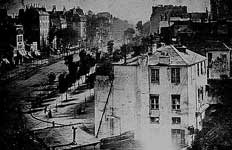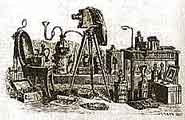Photography is a method of capturing images by the action of light, or a related radiation, on a sensitive material. The word photography - derived from the Greek words photos (light) and graphein (to draw) - was coined by English scientist Sir John F.W. Herschel in 1839.
The Birth of Photography ~
In 1827 French inventor Joseph Nicéphore Niépce was the first to obtain a true fixed photographic image. This first exposure took eight hours! Photography was born, but it was a long way from everyday use.
Louis-Jacques-Mandé Daguerré was born near Paris, France on November 18, 1789. While a professional scene painter for important opera houses during the 1820's, Daguerré began experimenting with the effects of light upon translucent paintings. In 1829, he formed a partnership with J. N. Niépce to improve the process Niépce had developed in 1827. Unfortunately, Niépce died in 1833, so Daguerré took over the development.
After several years of experimentation, Daguerré finally developed a more effective and convenient method of photography. His breakthrough process involved the affixing of a positive silver image over a sensitized metal sheet. He named the result of this process after himself -- the daguerréotype. In 1839, he and Niépce's son sold the rights for the daguerréotype process to the French government and published a booklet describing the revolutionary process.
The daguerréotype gained worldwide popularity very rapidly. By the mid 1800's, more than seventy-five daguerréotype studios were in operation in New York City alone.
|
|
|
|
|
|
J. N. Niépce
|
|
|
|
|
|
L. J. M. Daguerré
|
|
|
|
|
 |
|
A daguerréotype photograph ~ Exhibits a superb level of detail and unsurpassed image quality. A remarkable feature of the daguerréotype image is that they appear convincingly three-dimensional. Some see this as a drawback, though, because the image may seem to dissapear when viewed from odd angles.
|
|
|
|
|
|
|
|
A Paris street scene ~ By L. J. M. Daguerré
|
|
|
|
|
|
|
|
|
~ Vintage Photograph Gallery
|
What did distinguish these three print types from one another was their individual expense of production, and the resulting quality of each. See the Vintage Photo Gallery page for full-sized images and in-depth details on these, and other 19th century photographic styles and processes.
|
|
The Progress of Photography ~
Photography advanced considerably when sensitized materials were developed which could be coated on plate glass. The first glass negatives were wet plate. They had to be developed quickly before the emulsion dried. In the field this meant carrying along a portable development lab. Luckily for the roving photographer, processes were soon invented and patented which freed him from having to develop each print on the spot.
The ambrotype, which involved coating a glass negative with black lacquer to bring out the positive image, was developed by various photographer-experimenters in the early 1850's. The photographic process suddenly became much less expensive, more convenient, and much more accessible to would be photographers .
Although the ambrotype did facilitate a boom in the number of photographs taken worldwide, it had some major drawbacks, including a considerable loss of tonal quality and print durability. The worst thing about the ambrotype was, most were made with cheap, brittle glass. When the glass broke, the image was irretrievably lost.
Trivia: A vast majority of Civil War photographs were ambrotypes.
The tintype - patented in 1856 by Hamilton Smith - was another important medium development which helped to further the progress of photography. Practical and not overly expensive, Smith's process involved the use of a thin sheet of iron "tin" (sic) as a base for the light-sensitive, image yielding material. The tintype was a happy compromise between the daguerréotype and the ambrotype.
William Henry Fox Talbot - a contemporary of Daguerré's - Was inventor of the first process which used a negative from which multiple prints could be made.
By the 1860's, the daguerréotype and the ambrotype were largely replaced by the tintype and the newly developed paper photographs.
Coming Soon: 19th Century camera, and photographic development gallery.
|
|
|
|
In 1889, George Eastman, realizing the potential of the mass market, used a newly invented film with a base that was flexible, unbreakable, and could be rolled. Emulsions coated on a cellulose nitrate film base, such as Eastman's, made the mass-produced box camera a reality.Using the Kodak box camera, amateur photographers began to document everyday life in America.
Eastman's first simple camera in 1888 was a wooden, light-tight box with a simple lens and shutter that was factory-filled with film. The photographer pushed a button to produce a negative. Once the film was used up, the photographer mailed the camera with the film still in it to the Kodak factory where the film was removed from the camera, processed, and printed. The camera was then reloaded with film and returned.
Trivia: Inspiration for the name Kodak came from the cameras mechanical shutter sound - "ko-dak"
Kodachrome color film was introduced in 1935, and by the early 1940's several commercially viable color films were on the market. These films used the modern technology of dye-coupled colors in which a chemical process bonds three dye layers together to create an apparent color image. This system is still in use today.
Photography technology advances every day, but because the standards implemented by Eastman and his contemporaries remain excellent, we'll use essentially the same film photography technology well into the future. Of course, now, with the advent of the personal computer and the digital camera, who knows what exciting advances in photography the future will bring.
Coming Soon: The Brownie Box, and other early snapshot cameras.
|
|
|
|

